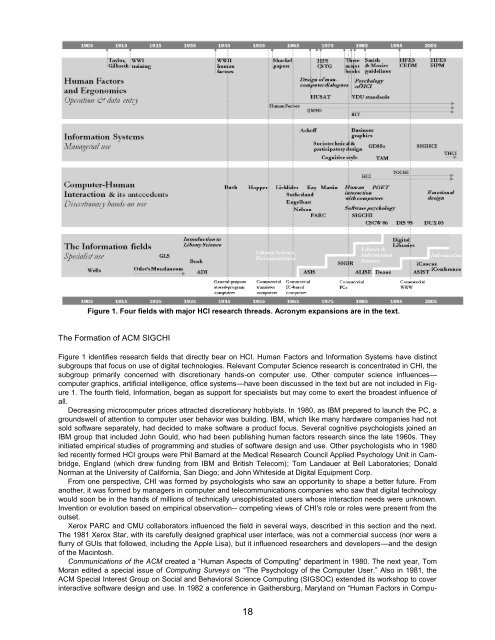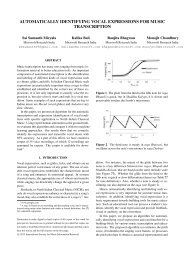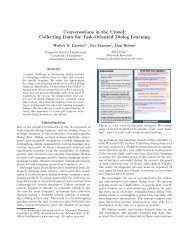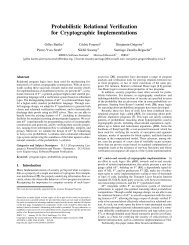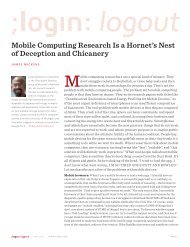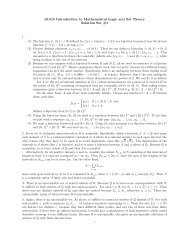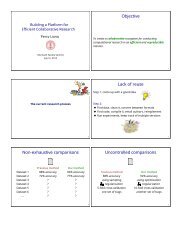A Moving Target—The Evolution of Human-Computer Interaction
A Moving Target—The Evolution of Human-Computer Interaction
A Moving Target—The Evolution of Human-Computer Interaction
You also want an ePaper? Increase the reach of your titles
YUMPU automatically turns print PDFs into web optimized ePapers that Google loves.
Figure 1. Four fields with major HCI research threads. Acronym expansions are in the text.<br />
The Formation <strong>of</strong> ACM SIGCHI<br />
Figure 1 identifies research fields that directly bear on HCI. <strong>Human</strong> Factors and Information Systems have distinct<br />
subgroups that focus on use <strong>of</strong> digital technologies. Relevant <strong>Computer</strong> Science research is concentrated in CHI, the<br />
subgroup primarily concerned with discretionary hands-on computer use. Other computer science influences—<br />
computer graphics, artificial intelligence, <strong>of</strong>fice systems—have been discussed in the text but are not included in Figure<br />
1. The fourth field, Information, began as support for specialists but may come to exert the broadest influence <strong>of</strong><br />
all.<br />
Decreasing microcomputer prices attracted discretionary hobbyists. In 1980, as IBM prepared to launch the PC, a<br />
groundswell <strong>of</strong> attention to computer user behavior was building. IBM, which like many hardware companies had not<br />
sold s<strong>of</strong>tware separately, had decided to make s<strong>of</strong>tware a product focus. Several cognitive psychologists joined an<br />
IBM group that included John Gould, who had been publishing human factors research since the late 1960s. They<br />
initiated empirical studies <strong>of</strong> programming and studies <strong>of</strong> s<strong>of</strong>tware design and use. Other psychologists who in 1980<br />
led recently formed HCI groups were Phil Barnard at the Medical Research Council Applied Psychology Unit in Cambridge,<br />
England (which drew funding from IBM and British Telecom); Tom Landauer at Bell Laboratories; Donald<br />
Norman at the University <strong>of</strong> California, San Diego; and John Whiteside at Digital Equipment Corp.<br />
From one perspective, CHI was formed by psychologists who saw an opportunity to shape a better future. From<br />
another, it was formed by managers in computer and telecommunications companies who saw that digital technology<br />
would soon be in the hands <strong>of</strong> millions <strong>of</strong> technically unsophisticated users whose interaction needs were unknown.<br />
Invention or evolution based on empirical observation-- competing views <strong>of</strong> CHI's role or roles were present from the<br />
outset.<br />
Xerox PARC and CMU collaborators influenced the field in several ways, described in this section and the next.<br />
The 1981 Xerox Star, with its carefully designed graphical user interface, was not a commercial success (nor were a<br />
flurry <strong>of</strong> GUIs that followed, including the Apple Lisa), but it influenced researchers and developers—and the design<br />
<strong>of</strong> the Macintosh.<br />
Communications <strong>of</strong> the ACM created a “<strong>Human</strong> Aspects <strong>of</strong> Computing” department in 1980. The next year, Tom<br />
Moran edited a special issue <strong>of</strong> Computing Surveys on “The Psychology <strong>of</strong> the <strong>Computer</strong> User.” Also in 1981, the<br />
ACM Special Interest Group on Social and Behavioral Science Computing (SIGSOC) extended its workshop to cover<br />
interactive s<strong>of</strong>tware design and use. In 1982 a conference in Gaithersburg, Maryland on “<strong>Human</strong> Factors in Compu-<br />
18


